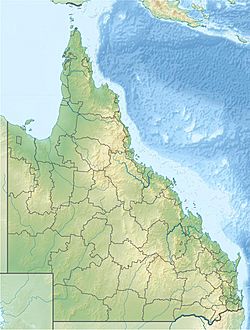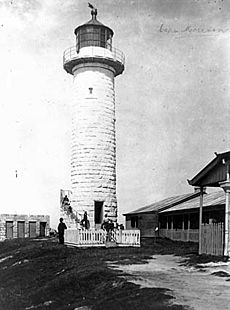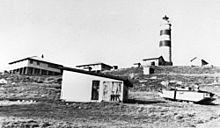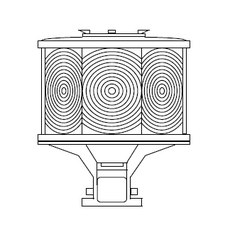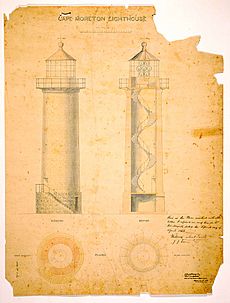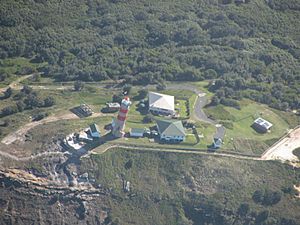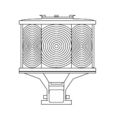Cape Moreton Light facts for kids
 |
|
| Cape Moreton Lighthouse, 2007 | |
|
|
|
| Location | Cape Moreton Queensland Australia |
|---|---|
| Coordinates | 27°01′54.4″S 153°27′57.1″E / 27.031778°S 153.465861°E |
| Year first constructed | 1857 |
| Construction | sandstone tower |
| Tower shape | tapered cylindrical tower with balcony and lantern |
| Markings / pattern | unpainted tower with two red horizontal bands in the upper half and red dome |
| Height | 75 feet (23 m) |
| Focal height | 400 feet (120 m) |
| Current lens | VRB-25 |
| Intensity | 14,000 cd |
| Range | 15 nautical miles (28 km; 17 mi) |
| Characteristic | Fl (4) W 20s. |
| Admiralty number | K2854.1 |
| NGA number | 111-5852 |
| ARLHS number | AUS-039 |
The Cape Moreton Light is an old and important lighthouse on Moreton Island in Queensland, Australia. It's also known as the North Point Range Rear Light. It helps ships find their way into Moreton Bay and to Brisbane. Its special red bands make it easy to spot during the day.
This lighthouse is the oldest in Queensland. It's also the only one built from stone. It was built by the Government of New South Wales before Queensland became a separate state in 1859.
The lighthouse was built because more ships started using the northern entrance to Moreton Bay in the 1840s. It was designed in 1854 by Edmund Blacket and finished in 1857. Over the years, the light source changed many times. It went from oil lamps to kerosene, then to acetylene gas, then electricity, and finally to solar power. The lighthouse also got taller in 1928–1930. Some other buildings at the station were rebuilt too.
The lighthouse station includes the main lighthouse, three homes for the lighthouse keepers, and other buildings. The lighthouse tower is made of sandstone. It has a concrete balcony and a metal lantern room at the top. The homes and most other buildings are made of timber frames with fibro panels.
Contents
Why Was the Lighthouse Built?
In 1825, Brisbane started as a penal colony (a place where prisoners were sent). At first, ships usually entered Moreton Bay from the south. This route was shorter and often had better conditions. So, the southern entrance was marked in 1825. A pilot station (where guides for ships worked) was set up at Amity Point in 1827.
Even though people thought about using the northern entrance in the 1830s, it wasn't until 1842 that more ships started using it. This was because Moreton Bay became a free settlement, meaning more trade and ships.
- In 1846–1847, buoys were placed to mark the northern entrance.
- In 1848, the pilot station moved to Bulwer on Moreton Island.
- By then, the northern entrance was seen as the main way in.
In 1850, people in Brisbane asked the New South Wales Government to build a lighthouse at Cape Moreton. New South Wales controlled Queensland until 1859. The government also wanted ships to use the wider and safer northern passage.
- Planning for the lighthouse started in 1852.
- The spot for the lighthouse was chosen and surveyed in 1853.
- The lighthouse was designed in 1854 by Edmund Blacket, who was the main architect for New South Wales at the time.
The tower was built by a contractor named Mark Farrell. It cost £15,232. Prison labor was used to help build it. Both the lighthouse and three sandstone homes for the keepers were made from local sandstone. The lighthouse first shone its light in February 1857.
The first light system used 21 oil lamps with parabolic reflectors. The lighthouse was about 67-foot-high (20 m). Its light could be seen for about 26.5 nautical miles (49.1 km; 30.5 mi).
Changes Over Time
In 1859, Queensland became a separate state. Control of the lighthouse passed to the Government of Queensland. In 1864, a telegraph office opened at the Cape. This allowed messages to be sent quickly.
- In 1873, the oil lamps were replaced with kerosene lamps.
- During the 1860s and 1870s, more buildings were added. These included a schoolhouse (opened in 1879), a stable, and storage buildings.
- A telegraph line was built in the 1890s.
- In the 1910s, a Morse lamp was installed. It could be seen for 20 miles (32 km).
In 1913, the wooden parts of the buildings were replaced because ants had damaged them. A survey in 1911–1913 found the lighthouse in good condition. However, the light system was old and needed to be updated. This update was delayed because all lighthouses along the coast were being transferred to the Australian Commonwealth government. This officially happened in October 1913, but practically in July 1915.
- Between 1915 and the early 1920s, the light keepers also ran a post office.
In 1928, the tower was made taller to increase how far its light could be seen. It reached its current height of 75 feet (23 m). From 1928 to 1930, the old keeper's cottages were replaced with new ones made of timber and fibro. In 1930, the lantern room at the top of the lighthouse was greatly changed. A new lantern room was installed. The light source was changed to acetylene gas, and a special "sun valve" was added. This valve would turn the light off during the day to save gas.
Electricity and Modernization
In 1937, the light was changed to use 110 V DC electricity. The two special red bands that make the lighthouse easy to spot were painted in 1942. In 1967, the power source was updated to 240 V AC power. This came from two diesel generators. A new lens and other parts might have been installed then too. The light in 1967 could be seen for 27 nautical miles (50 km; 31 mi).
The light was updated again in July 1988. A powerful halogen lamp was installed. In 1990, the handrails and supports on the balcony and outside stairs were replaced. A ladder was also added to reach the dome at the very top. On December 8, 1993, the light was changed to run on solar power. A modern VRB-25 light system was put in place.
How the Light Works Today
The light flashes four times, with 3.3 seconds between each flash. This happens every 20 seconds. It's a white light and can be seen for 15 nautical miles (28 km; 17 mi). The light source is a 12 V 35 W halogen lamp. It produces a bright light of 14,000 cd. The light spins three times every minute.
What the Station Looks Like
The buildings at the lighthouse station are built on three different levels of ground.
- On the highest level is the lighthouse itself. Around it are the workshop, the old powerhouse, and the fuel store. The head keeper's house and an office are also on this level.
- On the second level is the first assistant keeper's home, two sheds, a garage, and another powerhouse.
- On the lowest level is the second assistant keeper's home, which is a bit further away. There's also a fuel store to the north.
The Lighthouse Tower
The lighthouse tower is round and 18.5 metres (61 ft) tall from the ground to the top of the lantern. It's made of sandstone blocks laid in neat rows. The walls are thicker at the bottom. The tower gets a little narrower towards the top, where the cast iron lantern sits.
You can enter the tower through a wooden door on the ground floor. Or, you can use the original outside stone staircase from 1857. This staircase goes around the first floor and leads to another wooden door. The modern handrail on this staircase was added in 1990. The tower is mostly the natural sandstone color, but it has two red bands painted near the top.
- Both the ground floor and the lantern floor are made of concrete.
- Inside, you go up a ladder to the first floor. Then, you use the original spiral staircase made of cast iron. This leads to a landing below the lantern.
- Finally, another short ladder takes you to the lantern floor.
- The inside of the tower is painted. Small square glass panels in wooden frames let light in.
The top of the tower has the 1930 7 feet 1 inch (2.16 m) wide lantern, which is painted white. The lantern's round wall is made of six bolted cast iron panels. These panels hold a continuous band of curved glass. There's a small walkway between the wall and the glass. The dome on top of the lantern is made of copper sheets and painted red. It has a ball-shaped air vent and a wind vane at the very top. A ladder and safety rails, added in 1990, let people reach the dome. Inside the lantern is the VRB-25 light system, sitting on a steel box.
Around the lantern is a concrete balcony. You can get to it through a door in the lantern wall. It has a white painted balustrade and a railing added in 1990. The solar panels that power the light are placed on this balcony.
Other Buildings
The three homes for the keepers were built between 1928 and 1930.
- The head keeper's house is closest to the lighthouse and on the highest ground. It also has a small fenced garden.
- The first assistant keeper's house is to the west, on slightly lower ground.
- The second assistant keeper's house is further away to the south and on even lower ground.
These homes are square, one-story buildings. They have timber frames and fibro panels. They have central rooms with no hallways, enclosed verandahs, and hip roofs. The head keeper's house and the second assistant's house have corrugated fibrous cement roofs. The first assistant's house has a newer metal roof. In 1988, a museum was set up in the second assistant's house. Next to each house are two large, round steel tanks for collecting rainwater.
The three sheds around the lighthouse are:
- The workshop to the south.
- The old powerhouse to the west.
- The fuel store to the north.
These are all rectangular buildings with timber frames, fibro panels, and corrugated fibrous cement gable roofs. The workshop seems to be built on the remains of an older stone building. It has two rooms with sash windows and wooden doors.
The old powerhouse and the fuel store have strong reinforced concrete floors. They have fibro lining, double-hung sash windows, and double wooden doors.
The office, located north of the head keeper's house, is a small square room. It's raised on short concrete pillars. It has timber-framed fibro walls and a corrugated fibrous cement roof. It has a continuous band of windows.
The last three buildings—the garage, another powerhouse, and another fuel store—are small brick buildings. They have metal roofs and reinforced concrete floors.
Visiting the Lighthouse
The Australian Maritime Safety Authority manages the lighthouse and its operations. You can reach Moreton Island by ferry from Scarborough. However, you need a permit to visit, and you must have a four-wheel drive vehicle. You can visit the lighthouse station, but the lighthouse tower itself is not open to the public.
Heritage Status
The Cape Moreton Light was added to the Queensland Heritage Register in 2004. This means it is recognized as an important historical site.
Images for kids


